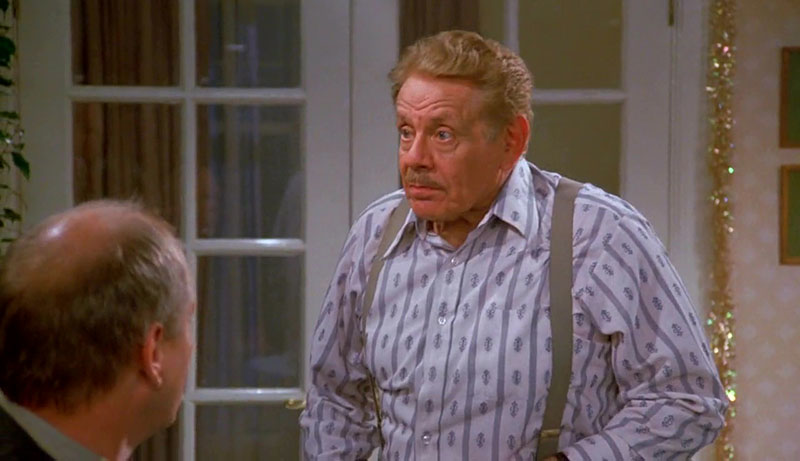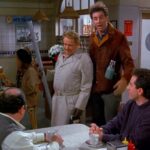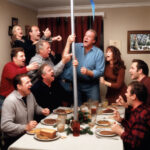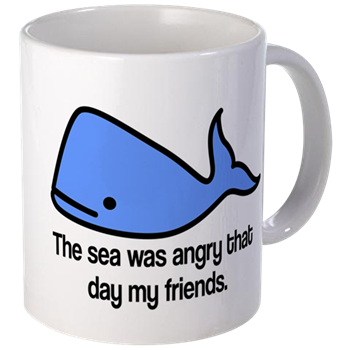The Origins of Festivus
Festivus was made popular by the Seinfeld episode "The Strike", written by Seinfeld writer Dan O'Keefe. However, Dan based the Seinfeld story on a "Festivus" holiday his own father invented back in the 1960s/1970s.
The O'Keefes (The "Real Festivus")
The idea of Festivus originally came to Seinfeld writer Dan O'Keefe from a tradition started by his father Daniel O'Keefe.
Daniel O'Keefe Sr. originally invented Festivus as a way to have a holiday that was secular and not burdened by the religious and commercialism of the holiday season. According to family folklore, the first Festivus occurred in 1966, on the occasion of the first date of Daniel and his soon to be fiancée Deborah. Throughout the 1970s/80s Daniel O'Keefe continued to make Festivus an annual tradition among the O'Keefe clan.

Festivus had no set date. It could occur at any time of the year, and usually never happened at Christmas. Daniel O'Keefe, who was inspired by the Samuel Beckett play Krapp's Last Tape, whose protagonist tapes himself speaking at different times in his life, used a tape recorder to record the proceedings, which included a portion where the family members spoke out about what was bothering them (Like the Airing of Grievances, but not officially named as such). In fact, the O'Keefe family still retains some of the tapes recorded at their own Festivus celebrations in the 1970s.
The O'Keefe version of the holiday did not include an aluminum pole, however it had other unique traditions:
"The O’Keefe Festivus had symbols and props which weren’t in
the Seinfeld version of the holiday. For example, one of the main symbols of the holiday was a “clock and a bag”, and sometimes a clock “in” a bag. The significance of the bag and the clock was unknown. Apparently, when the O’Keefe siblings would ask about
the meaning, Daniel O’Keefe Sr. would simply reply, 'That’s not for you to know!' How mysterious!
There were no costumes for Festivus, however hats were often worn. Some of the favorites were a Viking helmet (with Play-Doh horns affixed), a brimless Cub Scout cap (including tinfoil adornments) or a pointy dunce cap. These were typical accoutrements manufactured by a gang of creative youths."
~
Festivus! The Book
The following is taken from a New York Times article, based on an early interview with Dan O'Keefe:
"It was entirely more peculiar than on the show," the younger Mr. O'Keefe said from the set of the sitcom "Listen Up," where he is now a writer. There was never a pole, but there were airings of grievances into a tape recorder and wrestling matches between Daniel and his two brothers, among other rites.
"There was a clock in a bag," said Mr. O'Keefe, 36, adding that he does not know what it symbolized.
"Most of the Festivi had a theme," he said. "One was, `Is there a light at the end of the tunnel?' Another was, `Too easily made glad?' "
His father, a former editor at Reader's Digest, said the first Festivus took place in February 1966, before any of his children were born, as a celebration of the anniversary of his first date with his wife, Deborah. The word "Festivus" just popped into his head, he said from his home in Chappaqua, N.Y.
~
New York Times - 19 December 2004
Even though most of the O'Keefe Festivus traditions did not appear in the Seinfeld version of the holiday, one important O'Keefe element did. The phrase "A Festivus for the Rest of Us", which is uttered by Frank Costanza in the Seinfeld episode, was actually an O'Keefe family Festivus motto. Dan O'Keefe explained this in a 2009 Q & A session with the Washington Post:
"A Festivus for the Rest of Us" was an actual family Festivus motto, referring initially to those remaining after the death of my father's mother, and then coming to mean in general a forward-looking focus on life and the living, i.e. 'Let the dead bury the dead'."
For more information about the O'Keefe family Festivus, get a copy of The Real Festivus (2005) by Dan O'Keefe. He has managed to capture his family's holiday in all its strangeness. Additionally, Festivus! The Book devotes an entire chapter to the O'Keefe brand of Festivus.
How did Festivus come to Seinfeld
In 1996, a young Dan O'Keefe became a writer for the hit television program Seinfeld. It is common for writers to draw from their own experiences, however, it never crossed Dan's mind that his father's crazy holiday was worthy for television. It wasn't Dan's idea to include Festivus in the plot of a Seinfeld episode; it was the other Seinfeld writers who convinced Dan to make "Festivus" a sub-plot of an episode.
In a 2013 interview with Mother Jones Magazine, Dan O'Keefe admitted that he was originally not convinced the Festivus storyline was a good idea, and he actually "fought against it". Fortunately, for Festivus aficionados, his fellow writers, and Jerry Seinfeld himself, backed the idea:
Sixteen years ago, O'Keefe and his family gave the world Festivus—by accident. Before Seinfeld's ninth season, it was the O'Keefe family's annual tradition, invented by his dad—a big fan of Pabst Blue Ribbon, coincidentally. "It was fucking weird, man," O'Keefe recalls. "It did not have a set date...We never knew when it was going to happen until we got off the school bus and there were weird decorations around our house and weird French '60s music playing." The pole itself, however, was an invention of the Seinfeld writers room, and the episode's other two writers Alec Berg and Jeff Schaffer. One day in 1997, one of O'Keefe's brothers let it slip to a member of the Seinfeld staff that this family holiday existed, and the crew thought thought was funny enough to write into the series. "I didn't pitch it. I fought against it," O'Keefe says. "I thought it would be embarrassing and drag the show down, but...Jerry liked it." - Mother Jones Magazine 12 December 2013
Further details of how Dan O'Keefe was convinced to include his father's holiday in Seinfeld, can be found in Festivus! The Book:
Other Seinfeld writers, relentless in their hunt for a comedy angle, forced Dan to spill all the details of his family Festivus. As Dan recalls, he was "dragged into it against my will by Alec Berg, Jeff Schaffer and Dave Mandel, who literally sat me down and refused to let me leave a diner until I agreed to write it into an episode." Once Dan had finally told the story of Festivus, "They were just speechless due to the sheer oddity of it". However, they unanimously came to the conclusion, "This needs to be on television, the story needs to be told."
At the time of the episode's release, writer Dan O'Keefe really had no idea how his family's zany holiday would leave a mark on society. The network ratings for "The Strike" were very good, however Seinfeld was one of the most popular series at the time and the good ratings were not abnormal. Clearly though, a Festivus seed had been planted.
The Traditional Costanza Festivus

Let's Rumble!
The Festivus that most people know of is the version that is depicted in the Seinfeld Season 9 Episode, "The Strike".
In that episode, the origin of the Festivus celebration was the result of one man's refusal to conform to the increased commercialism and consumerism which has saturated the December holiday season. Frank Costanza, during a routine outing to secure a Christmas gift for his son George, realized that there should be a new holiday:
Frank Costanza: Many Christmases ago, I went to buy a doll for my son. I reached for the last one they had, but so did another man. As I rained blows upon him, I realized there had to be another way.
Cosmo Kramer: What happened to the doll?
Frank Costanza: It was destroyed. But out of that a new holiday was born … a Festivus for the rest of us!
Cosmo Kramer: That must've been some kind of doll.
Frank Costanza: She was.
The Seinfeld episode, "The Strike", included many other Festivus oddities that were invented by Frank Costanza. The Festivus Pole, for example is a favorite today, but if you read above you will see that the Festivus pole was only part of the Seinfeld version of the holiday, and not an invention of the original O'Keefe version of Festivus.











 Join our Facebook Page: "I Celebrate Festivus"
Join our Facebook Page: "I Celebrate Festivus"